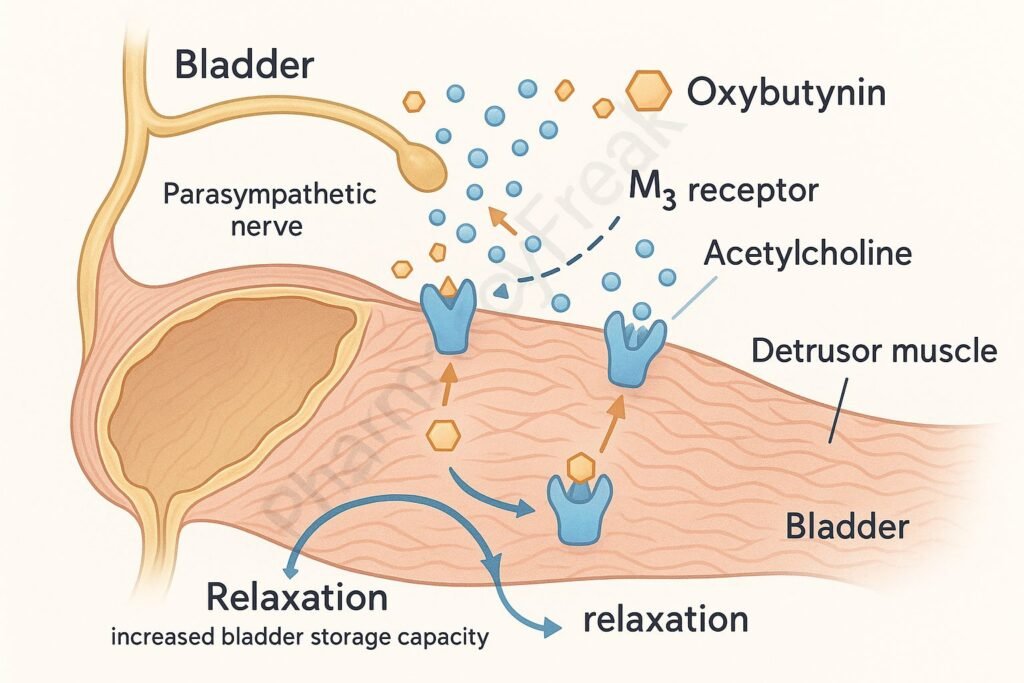Table of Contents
Introduction
Oxybutynin is an antimuscarinic agent used primarily in the treatment of overactive bladder (OAB) and urinary incontinence. It reduces urinary urgency and frequency by inhibiting involuntary bladder contractions. Its dual mechanism—anticholinergic and direct smooth muscle relaxant properties—makes it effective for bladder control with additional benefits in neurogenic bladder conditions.


Mechanism of Action (Step-wise)
1. Antagonism at Muscarinic Receptors (M3 subtype)
Oxybutynin competitively inhibits acetylcholine at muscarinic receptors, especially M3 receptors in the detrusor muscle of the bladder.
2. Inhibition of Detrusor Muscle Contraction
By blocking M3 receptors, it prevents acetylcholine-induced contractions of the bladder smooth muscle, reducing urgency and involuntary voiding.
3. Direct Antispasmodic Action
Oxybutynin also has a direct smooth muscle relaxant effect independent of anticholinergic activity.
4. Reduction in Bladder Pressure and Frequency
These actions lead to decreased bladder tone, increased bladder capacity, and reduced urgency and frequency of urination.
5. Central and Peripheral Anticholinergic Effects
Due to its lipophilicity, oxybutynin can cross the blood-brain barrier, potentially causing CNS effects in sensitive individuals.

Pharmacokinetics
- Route of Administration: Oral, transdermal patch, topical gel
- Bioavailability (oral): ~6% (due to first-pass metabolism)
- Time to Peak Plasma: 1–2 hours (oral)
- Half-Life: 2–5 hours
- Metabolism: Hepatic via CYP3A4
- Excretion: Renal and fecal
Clinical Uses
- Overactive bladder (OAB)
- Urge urinary incontinence
- Neurogenic bladder (e.g., spinal cord injury)
- Nocturnal enuresis (off-label)
Adverse Effects
- Dry mouth
- Constipation
- Blurred vision
- Dizziness and drowsiness
- Urinary retention
- Confusion (especially in elderly)
- Contraindications: Narrow-angle glaucoma, urinary retention, gastric retention
Comparative Analysis
| Parameter | Oxybutynin | Tolterodine |
|---|---|---|
| Mechanism | Antimuscarinic | Antimuscarinic |
| Receptor Selectivity | M1, M2, M3 (non-selective) | M2, M3 (more selective) |
| Lipophilicity | High | Moderate |
| CNS Side Effects | More common | Less common |
| Dosage Forms | Oral, patch, gel | Oral |
Multiple Choice Questions (MCQs)
1. What is the primary receptor target of oxybutynin?
a) Beta-3 adrenergic
b) M3 muscarinic receptor
c) Nicotinic receptor
d) Alpha-1 adrenergic
Answer: b) M3 muscarinic receptor
2. Oxybutynin is used mainly to treat:
a) Constipation
b) Urinary incontinence
c) Hypertension
d) Asthma
Answer: b) Urinary incontinence
3. One of the major side effects of oxybutynin is:
a) Hypoglycemia
b) Dry mouth
c) Bradycardia
d) Hyperkalemia
Answer: b) Dry mouth
4. The oral bioavailability of oxybutynin is low due to:
a) Poor solubility
b) Rapid renal excretion
c) Extensive first-pass metabolism
d) Enzyme induction
Answer: c) Extensive first-pass metabolism
5. Oxybutynin should be avoided in patients with:
a) COPD
b) Narrow-angle glaucoma
c) GERD
d) Migraine
Answer: b) Narrow-angle glaucoma
FAQs
Q1. Can oxybutynin be used in children?
Yes, under medical supervision, especially for enuresis and neurogenic bladder.
Q2. What is the advantage of transdermal oxybutynin?
Reduced dry mouth and GI side effects compared to oral form.
Q3. Is oxybutynin safe during pregnancy?
It should be used only if clearly needed and prescribed.
Q4. Can oxybutynin cause memory issues?
Yes, especially in the elderly due to CNS penetration.
Q5. What is the typical dosing schedule?
Usually 5 mg two to three times daily (oral), adjusted based on tolerance and response.
References
- Goodman & Gilman’s The Pharmacological Basis of Therapeutics, 12th Edition
- KD Tripathi, Essentials of Medical Pharmacology, 7th Edition
- Oxybutynin Prescribing Information
- Clinical guidelines for overactive bladder management
Related Internal Links

I am pursuing MBA in pharmaceutical management from NIPER Hyderabad with a strong academic record and proven success in national-level pharmacy entrance exams. I secured AIR 61 in NIPER 2024 (MS/M.Pharm) and AIR 27 in NIPER MBA, along with AIR 147 in GPAT 2024 and AIR 907 in GPAT 2023. I also achieved AIR 6 in AIIMS CRE-2025 for Drug Store Keeper and was selected as a Pharmacist (AIR 61) for ESIC. Additionally, I was the Runner-Up in Round 2 of the EY Case Study Competition.
At PharmacyFreak.com, I aim to guide future pharmacists through expert content, exam strategies, and insightful resources based on real experience and academic excellence.
Mail- harsh@pharmacyfreak.com
